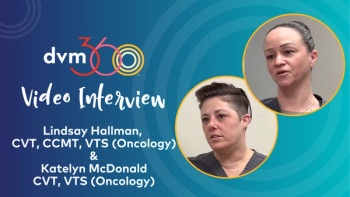
Veterinary Vexations: Collaring good choices
Whether the push is for diagnostics, optimal treatments, or solid preventive measures, leading owners to sound decisions for their pets’ health might be the veterinarian’s toughest task.
The quandary:
My clients hold their pets’ lives in their hands, yet often miss the mark when making medical choices for them, despite my counsel. What can I do to sway them in healthier directions?
The solutions:
We’ve all tried to pry open those black boxes inside our clients’ heads that explain the eternal contradictions: the owner who adorns her dog with pricey bling, but won’t spring for x-rays to clarify 3 days of vomiting. The one who stockpiles parasite preventives, but declares vaccines unnecessary. Or the pet owner who tags her overweight cat as her BFF, but won’t chisel him down to a healthy weight that might prolong their love.
We offer our clients strings of medical pearls, but our words often fall flat, said Samantha Siess, DVM, PhD, who studies risk perception, communication, and medical decision-making in both human and veterinary medicine. “Communication is as vital as the medicine itself,” she said.
Michele Campellone, VMD, owner of The Visiting Vet, LLC, a mobile veterinary clinic servicing Montgomery County, Pennsylvania, practices this daily.She estimates that only 60% of her clients go with her recommendations on the first pass. But she’s prepared for their reticence—and she prepares them, too. A “no” to wellness diagnostics? “I say, ‘If we’re not going to do it this year, then we’ll definitely do it next year, since he’ll be a year older,’” she explained.
And to the client who can’t say “no” to that hefty cat who wails for food? “I tell them: ‘There’s a 90% chance he is going to become diabetic. It’s better for your cat to be crying for food than for you to be crying because you’re having trouble giving the insulin,’” Campellone said.
Preventive health initiatives, from simple (vaccines, flea and tick prophylaxis, etc) to complex (diet and exercise), vary by time, money, and effort required. They can be a tough sell, Siess said, because they are directed toward healthy-looking animals not yet in need.
“Remind them that their pet doesn’t have to be acting sick to have something brewing,” she suggested. “And that there is benefit to starting treatment when they are still acting fine.”
Wellness blood work, Siess advises owners, might flag problems like climbing kidney values that could be addressed with a renal diet.
Siess’s research1 shows that the ‘doom and gloom’ approach is a poor motivator. “People are more likely to respond to, ‘If you give this vaccine, your pet will be healthy’ than ‘If you don’t give it, you risk death for your pet,’” she explained.
“The more threatening a statement, the more likely they are to think, ‘That won’t be me.’”
But whether diagnostics serve up wellness baselines or sickness workups, they all involve numbers.And numbers are intangible. For an owner whose cat is drenching the couch in urine, an antibiotic offering a potentially quick fix is more appealing than a list of Latin-lettered microbes and minimum inhibitory concentrations on a urine culture.
Though there are possible detriments to empiric antibiotics, Siess said, “they want that tangible.”
Campellone understands this and strives to make amorphous values real for her clients. Every report, once explained, gets emailed to them. She reminds owners that the diagnostic measurements they now have in their possession serve as baselines for future comparison and provide essential data to emergency doctors should the pet ever face a crisis.
According to the 2021 Consumer Expenditure Surveys, veterinary services accounted for just one-third of total spending on pets,2 with the lion’s share going to food, supplies, and ancillary services like grooming and training. If your client would sooner pay for deer antlers and pet psychic readings than blood pressure and urine protein-to-creatinine ratios, it may be a not-so-simple issue of communication.
Practice management consultant Wendy S. Myers, who runs Sarasota, Florida-based Communication Solutions for Veterinarians, says good communication always starts with financials. She said disclosing costs up front helps build trust. But she prefers the term fee (fees are nonnegotiable quantities, and are linked to professional services) to price.
But money is just part of the equation, noted James Morrisey, DVM, DABVP, postdoctoral fellow in veterinary communication at Colorado State University (CSU) College of Veterinary Medicine and Biomedical Sciences in Fort Collins. “We tell owners, ‘This is the test, and this is the cost.’But we don’t explain the value,” he said.
We cannot communicate the value of a visit without learning the pet parent’s agenda for the appointment. Instead, we often resort to what Morrisey refers to as “Spanish Inquisition of questions”: Coughing? Sneezing? Vomiting? Diarrhea?
He said yes-or-no questions like these don’t build the rapport necessary to discover a client’s goals.But open-ended inquiries, such as “What brings you in today?” or “Describe how Maisy’s energy level has changed recently,” draw more information, improve communication efficiency,3 and make the client feel heard.
In a study examining veterinarian solicitation of client concerns in companion animal practice,3 fewer than half of the appointments saw a veterinarian pose a single question to the pet owner. And of those questions, 1 in 4 was closed-ended.
To compound matters, veterinarians interrupted owners in 55% of their appointments.3 This often led to incomplete replies and owners’ concerns being put off until the last moments of appointments.
If we are trying to influence our clients’ behaviors, Morrisey said, we need to open our ears more. “If clients don’t feel like we’re listening to them, they’re not going to be listening to us.”
The nuances of communication between doctor and pet parent are now part of the curriculum at many US veterinary schools. In programs like those at CSU and Cornell University College of Veterinary Medicine in Ithaca, New York, veterinary students can practice tough conversations through role-playing with simulated clients.
They learn skills like reflexive listening, a trust-builder that prompts the doctor to demonstrate they are listening by repeating back what was said (“I hear you are concerned about Copper’s urinating in the house”). Students also pick up techniques like signposting, which employs words and phrases that can help redirect the narrative so that an appointment moves forward in a meaningful direction (“But let’s talk for a minute about Copper’s weight loss”).
Siess said constructive communication can set into motion owner choices and behaviors that are optimal for their pets. But when a pet parent shrugs off your advice, she suggests meeting those hesitations head-on.
What’s holding them up? Do they understand their pet’s condition? Are they concerned about putting their animal through testing or therapy?Are there financial concerns?Is “Dr Google” saying something different?
“Anecdotally, people tend to say, ‘Well, I read this online,’” Siess observed, “rather than take the advice of the clinician in front of them who has seen (the condition) many times and is now applying this knowledge to their pet.”
Given that pet owners tend to trust the written word—sometimes more than the spoken—Siess said veterinarians might take a page out of human medicine and populate their clinics with written decision aids. These might include vaccine pamphlets that lay out risk factors and tailor protocols to different pet profiles. Or flowcharts that make chronic health conditions seem more manageable.
Campellone employs visuals heavily to keep her mobile clientele engaged. “I always draw pictures for owners,” she said. “I show them what I’m doing, even if it’s just expressing anal glands. I’m constantly teaching them.”
REFERFENCES
- Siess S, Marziliano A, Sarma EA, Sikorski LE, Moyer A. Why psychology matters in veterinary medicine. Top Companion Anim Med. 2015;30(2):43-47. doi:10.1053/j.tcam.2015.05.001
- Table R-1. All consumer units: annual detailed expenditure means, standard errors, coefficients of variation, and weekly (D) or quarterly (L) percent reporting, Consumer Expenditure Surveys. 2021. US Bureau of Labor Statistics. September 2022. Accessed November 4, 2025.
https://www.bls.gov/cex/tables/calendar-year/mean/cu-all-detail-2021.pdf - Dysart LM, Coe JB, Adams, CL. Analysis of solicitation of client concerns in companion animal practice. J Am Vet Med Assoc. 2011;238(12). doi:10.2460/javma.238.12.1609
Newsletter
From exam room tips to practice management insights, get trusted veterinary news delivered straight to your inbox—subscribe to dvm360.






